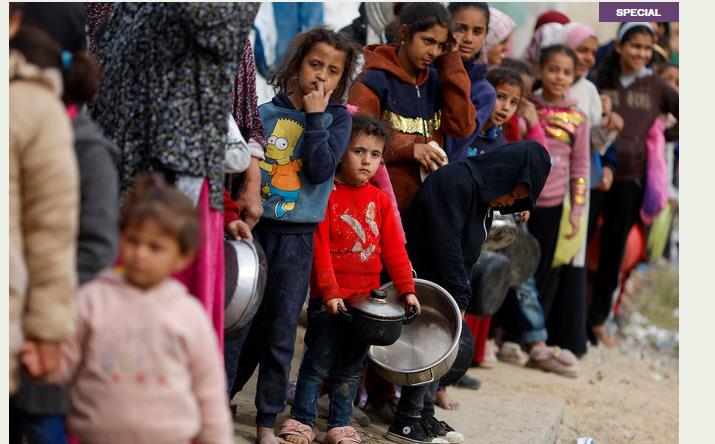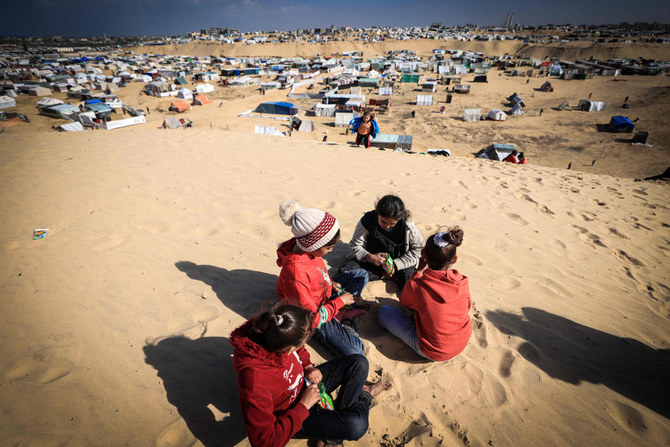
People displaced from their homes waiting for food at Al-Shaboura Camp, in the centre of Rafa, Gaza on 17–18 December 2023. Photo credit: WHO
21 December 2023 – Hunger is ravaging Gaza, and this is expected to increase illness across the Strip, most acutely among children, pregnant and breastfeeding women, and older people.
In new estimates released today, the Integrated Food Security Phase Classification (IPC) global partnership, which includes WHO, said Gaza is facing “catastrophic levels of food insecurity,” with the risk of famine “increasing each day.”
An unprecedented 93% of the population in Gaza is facing crisis levels of hunger, with insufficient food and high levels of malnutrition. At least 1 in 4 households are facing “catastrophic conditions”: experiencing an extreme lack of food and starvation and having resorted to selling off their possessions and other extreme measures to afford a simple meal. Starvation, destitution and death are evident.
On recent missions to north Gaza, WHO staff say that every single person they spoke to in Gaza is hungry. Wherever they went, including hospitals and emergency wards, people asked them for food. “We move around Gaza delivering medical supplies and people rush to our trucks hoping it’s food,” they said, calling it “an indicator of the desperation.” Infectious diseases are thriving
Gaza is already experiencing soaring rates of infectious diseases. Over 100 000 cases of diarrhoea have been reported since mid-October. Half of these are among young children under the age of 5 years, case numbers that are 25 times what was reported before the conflict.
Over 150 000 cases of upper respiratory infection, and numerous cases of meningitis, skin rashes, scabies, lice and chickenpox have been reported. Hepatitis is also suspected as many people present with the tell-tale signs of jaundice.
While a healthy body can more easily fight off these diseases, a wasted and weakened body will struggle. Hunger weakens the body’s defences and opens the door to disease.
Malnutrition increases the risk of children dying from illnesses like diarrhoea, pneumonia and measles, especially in a setting where they lack access to life-saving health services.
Even if the child survives, wasting can have life-long impacts as it stunts growth and impairs cognitive development.
Breastfeeding mothers are also at high risk of malnutrition. From 0-6 months of age, a mother’s milk is the best and safest food a baby can get. This protects the child from nutritional deficiencies and catching deadly diseases such as diarrhoea, especially when access to safe drinking water is extremely limited.
Mental health issues, on the rise across the population in Gaza, including among women, could further impact breastfeeding rates. Lack of sanitation and hygiene, and a collapsing health system, add to the toxic mix
Over 1.9 million people have been displaced from their homes, of whom over 1.4 million are staying in overcrowded shelters. These conditions are ripe for a continued rise in infectious diseases. In Gaza today, on average, there is only one shower for every 4500 people and one toilet for every 220. Clean water remains scarce and there are rising levels of outdoor defecation. These conditions make the spread of infectious diseases inevitable.
Tragically, access to health services across Gaza has plumeted as the war continues to degrade the health system. With the health system on its knees, those facing the deadly combination of hunger and disease are left with few options.
The people of Gaza, who have already suffered enough, now face death from starvation and diseases that could be easily treated with a functioning health system. This must stop. Food and other aid must flow in far greater amounts. WHO reiterates its call for an immediate humanitarian ceasefire.












